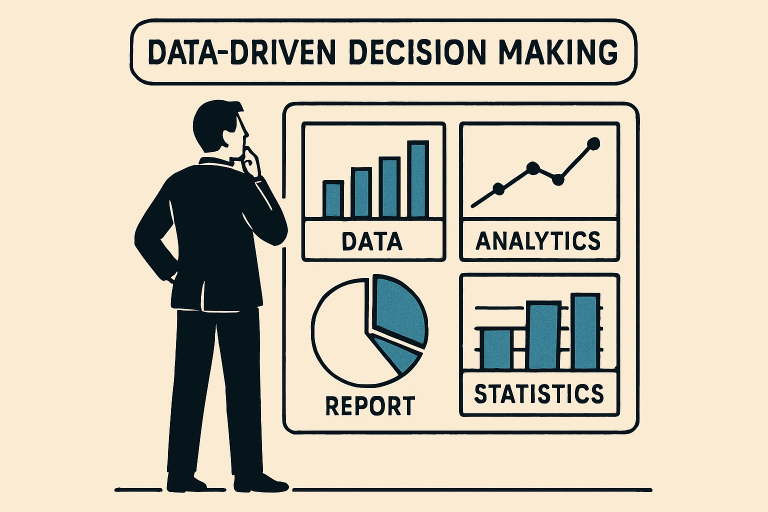Table of Contents
What Is Data Analytics?
Data analytics is the systematic computational analysis of data, aimed at discovering useful insights, patterns, and trends that support better decision-making. This discipline transforms raw, unorganized data into clear, actionable intelligence, empowering businesses to act with more precision and confidence. Whether it’s understanding customer preferences or optimizing supply chains, data analytics now plays a crucial role in business strategies globally.
As organizations look to gain a competitive edge, many turn to experts like Stratford Analytics to help uncover valuable business insights from vast datasets. By employing robust analytical frameworks, businesses can minimize risk, drive innovation, and boost performance through carefully aligned data initiatives.
Benefits of Data-Driven Decision Making
Organizations that adopt data-driven methodologies enjoy measurable improvements across all aspects of their business. Relying on actionable, data-backed evidence for every major decision reduces uncertainty and bias, improving outcomes and strengthening the organization’s core value proposition. According to a report by MIT Sloan, companies that prioritize analytics can see as much as a 5-6% boost in overall productivity.
- Improved accuracy in financial and operational forecasting lowers costly mistakes.
- Faster, more informed responses to changing customer demands and market conditions.
- Efficiency gains across departments, as teams align around clear, data-supported goals.
Data-driven cultures also foster transparency and accountability, helping business leaders identify not just growth opportunities, but also critical risks before they escalate.

Real-World Applications for Modern Businesses
Today’s most successful enterprises are those that have woven analytics into the fabric of their daily operations. In retail, businesses predict and respond to shifting demand by analyzing shoppers’ historical purchasing patterns and browsing behaviors. Healthcare organizations use analytics to track health trends and predict patient needs, improving outcomes and reducing costs. Banks and fintechs detect fraud by monitoring suspicious account activity in real-time, saving billions annually. Analytics isn’t just for giants; startups and mid-sized firms use web, social, and sales data to improve marketing, operations, and customer service. McKinsey reports that top analytics users often outperform peers in revenue and customer satisfaction.
The Essential Tools Businesses Need
Essential analytics tools range from spreadsheets to advanced business intelligence platforms and cloud-based systems. While Excel is useful for basic analysis, more complex needs require big data, dashboards, and automated reporting tools. Platforms like Tableau, Power BI, and Google Data Studio help visualize trends quickly, making complex info accessible to decision-makers. For large data sets, solutions like Apache Hadoop and cloud services from AWS and Google Cloud are vital. Choosing the right tools involves careful consideration to align with business goals and team skills.
Overcoming Common Challenges in Data Analytics
Despite benefits, harnessing analytics faces obstacles like poor-quality data, training, and system integration issues. Overwhelm occurs when data strategies lack clear ties to business outcomes, especially without strong governance. To overcome these, invest in staff training, structured data stewardship, set clear goals, monitor metrics, perform regular audits, ensure robust integration, and foster curiosity to ensure long-term success.
Emerging Trends and the Future of Data Analytics
Rapid advancements in artificial intelligence and machine learning define the future of data analytics. These technologies enable businesses not only to analyze past events but also to predict future trends and automate routine data-related tasks. Real-time analytics are becoming the norm, permitting decisions and actions at the speed of business operations.
Another critical trend is the growing emphasis on the ethical use of data and privacy. Regulatory pressures and growing public awareness are compelling organizations to rethink how they collect, store, and leverage customer information. By following developments from major industry sources, such as the Forbes Technology Council, companies can remain both innovative and responsible in their analytics approach.
How Organizations Can Get Started
Embarking on a data analytics journey doesn’t require an immediate overhaul. Start by identifying a pressing business question and gathering relevant data to explore solutions. Pilot analytics initiatives within specific departments or projects to build internal expertise and demonstrate quick wins. Over time, expand these capabilities across the organization, always aligning analytics priorities with broader business strategies.
Investing in staff training, promoting data literacy, and collaborating with external experts are practical first steps to cultivating a sustainable, data-driven culture. Clear communication and leadership support will help ensure analytics becomes a central driver in ongoing digital transformation.
Conclusion
Data analytics enables businesses to move beyond guesswork and make informed decisions based on evidence. By uncovering patterns, predicting trends, and providing actionable insights, leaders can respond to challenges with clarity and confidence. As organizations continue to embrace data-driven strategies, those that leverage analytics effectively will gain a competitive edge, foster innovation, and drive sustainable growth.
